Report into near-miss between bus and train in Christchurch recommends KiwiRail work with road controlling authorities to improve risk management for unplanned disconnections of level-crossing protections. KiwiRail disconnected the Selwyn Street level crossing when a fault could not be repaired on the day it was identified. There was no traffic management in place because KiwiRail hadn’t told council that due to an unplanned disconnection, the signals were not working.
Executive summary Tuhinga whakarāpopoto

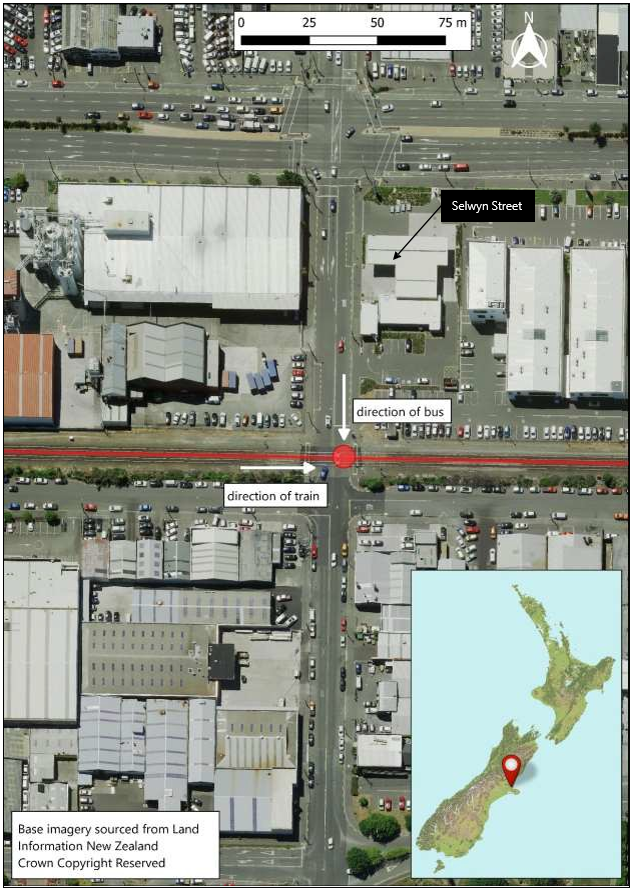
What happened
- On Saturday 6 August 2022, train control (based in Wellington) became aware of a signalling fault in the Christchurch area. Level crossing alarms at three different locations had defaulted to ‘fail-safe mode’, meaning that warning lights, bells and barrier arms were constantly activated. This was causing problems for road traffic in the area.
- The signals staff who were called out to repair the fault were unable to trace it within their allowable working hours, therefore they disconnected the Selwyn Street level crossing as per standard operating instructions. This allowed road traffic to enter the level crossing without the need for manual operation of the level crossing alarms and barriers.
- The Selwyn Street level crossing alarm system was disconnected from its power source. The barrier arms were raised and secured. Bags were placed over the alarm lights to show they were out of service. Train control imposed a 10 kilometre per hour speed restriction on any rail traffic approaching Selwyn Street and the other affected level crossings.
- On Monday 8 August 2022, while the level crossing remained disconnected, a ‘Go Bus’-operated Christchurch Metro passenger bus drove across the Selwyn Street level crossing as a KiwiRail locomotive approached. The bus passed approximately 12 metres in front of the locomotive, creating a ‘near-miss’ situation. There was no collision, no damage and no injuries.
Why it happened
- The signalling cable that controlled the level crossings had been partially cut through. Because of the nature of the partial cut, the location of the fault was not readily apparent to signals staff. This delayed the process of identifying and rectifying the problem.
- Because the fault occurred on a weekend, limited signals staff were available. When the attending signals staff had worked their allowable hours they left the site after following KiwiRail procedures for disconnecting alarms.
- KiwiRail’s procedure for disconnecting the level crossing alarms and barriers did not adequately address the risk posed by leaving the level crossing unattended.
- There was no requirement in KiwiRail’s procedures to inform the road controlling authority that the level crossing was disconnected. As a result, no form of temporary traffic management was put in place until after the near miss between the bus and train was reported.
What we can learn
- Risk assessments and associated mitigations are based on the controls in place at the time of the assessment. Removal of any of these risk controls without reassessment may increase risk to an unacceptable level.
Who may benefit
- Railway signals and communications staff, network controllers, road users, road controlling authorities and people involved with work around road–rail interfaces may all benefit from the findings and recommendations in this report.
Factual information Pārongo pono
Narrative
- At about 0600 (times in this report are New Zealand Standard Time and are expressed in 24-hour mode) on Saturday 6 August 2022, train control became aware of a fault with the level crossing alarms at Lincoln Road, Selwyn Street and Grove Road in Addington, Christchurch. A train controller, based in Wellington, took manual control of the level crossing alarms for the level crossings at Lincoln Road and Grove Road, but the train control system did not provide for manual control of the level crossing at Selwyn Street.
- Through the internal KiwiRail fault-logging network, the train controller organised for a signals technician to attend and investigate the fault. They also issued a verbal temporary speed restriction (TSR) of 10 kilometres per hour (km/h) for trains approaching the area, as required by the Task Instruction for level crossing faults (see Appendix 1).
- Network Operations in Wellington issued a Special Bulletin advising of a 10 km/h TSR with speed boards not in place because of a disconnected warning device.
- At about 0630 when the signals technician arrived at the Selwyn Street level crossing, the level crossing alarms were operating in ‘fail-safe’ mode. The bells were ringing, the lights were flashing and the barrier arms were lowered across the road approaches. Road traffic had backed up and some vehicles were entering the level crossing despite the alarms.
- KiwiRail did not inform either NZ Police or the road controlling authority (Christchurch City Council (CCC)) of the malfunctioning level crossing alarms and barriers and the effect this was having on road-user behaviour.
- The signals technician checked the track relays and found that they were all up8, thus eliminating a track fault such as a broken rail as the cause of the malfunction. However, other relays were down and causing the alarms to ring. The signals technician tried to take manual control to bypass the alarms, but this was unsuccessful. They then bypassed the affected circuits to operate the barrier control relay. This process took several minutes from the arrival of the signals technician on site before the crossing was able to be opened to road users.
- Throughout this time, the signals technician was in contact with train control and arranged with train control to ensure that no rail traffic entered the level crossing. The signals on either side of the Selwyn Street level crossing were held at stop, so that any approaching rail traffic had to stop and obtain permission from train control before continuing. Train control would then call the signals technician so that they could operate the barriers and alarms before the train controller gave the train driver verbal permission to enter the level crossing.
- The signals technician then moved to the next stage of fault finding, which was inspecting the signalling cable that controlled the level crossing.
- Railway signalling cables are a critical component of the signalling system, used to transmit electrical signals between different signalling equipment, such as track circuits, signals or, in this case, the level crossing bells, alarms and barriers.
- Signalling cables consist of multiple wires or conductors, each of which carries a specific electrical signal. The signals are transmitted using a variety of techniques, including voltage, current and frequency modulation. The specific method used depends on the signalling system’s requirements and the type of signalling cable being used.
- Such cables are normally ‘daisy-chained’ – sectionalised into shorter individual lengths, allowing for more accurate and quicker fault finding. However, this particular cable was one continuous length starting from the Addington signal box location.
- A meter reading conducted by the signals technician showed that there was intermittent resistance in the cable, indicating that a cable joint had been partially pulled apart. They started the standard fault-finding procedure of working through sections of the cable to locate the fault. However, there were 760 metres of cable to examine between the Addington signal box and the Selwyn Street location.
- As there was a significant amount of work to be conducted, the signals technician made several phone calls to find assistance. One of KiwiRail’s signals field engineers attended and the two continued with attempts to locate the fault.
- Whenever a train approached the level crossing, one of the signals staff had to stop their fault-finding work to operate the level crossing alarms and barriers using local manual controls. Road traffic would then stop and allow the train to pass safely.
- On Saturday afternoon one of the signals technicians called the Signals and Telecommunications Electrical Manager (the Manager) to request the use of a specialised cable fault locator. They discussed the situation and the Manager decided to drive to site to deliver the equipment and help to trace the fault. The Manager arrived on site at about 1500.
- Initial fault finding indicated that six circuits were not working. However, attempts to bypass these circuits revealed further unidentified problems, meaning that the circuits could not simply be bypassed. As it started to get dark, and the signals technician had been working for almost 12 hours, a decision was made to take the level crossing alarms out of use. The procedure for disconnecting a level crossing was contained in KiwiRail’s Signals and Telecommunications task instructions (see Appendix 1). The procedure involved imposing a 10 km/h speed restriction for rail traffic (which had already been done), pulling the fuses that power the bells, lights and barriers, tying up the barrier arms, placing high-visibility orange bags over the warning lights, and placing ‘signals not working’ signage (see Figure 3).
- The signals nearest to the level crossing were fixed at stop, and rail traffic was required to obtain permission from train control to go past the signals. However, the status of road traffic on the level crossing was not a consideration when such permission was granted as train control had no visibility of road traffic. Once permission was granted to pass the signals, rail traffic entered the level crossing without the lights, bells or barriers being activated.
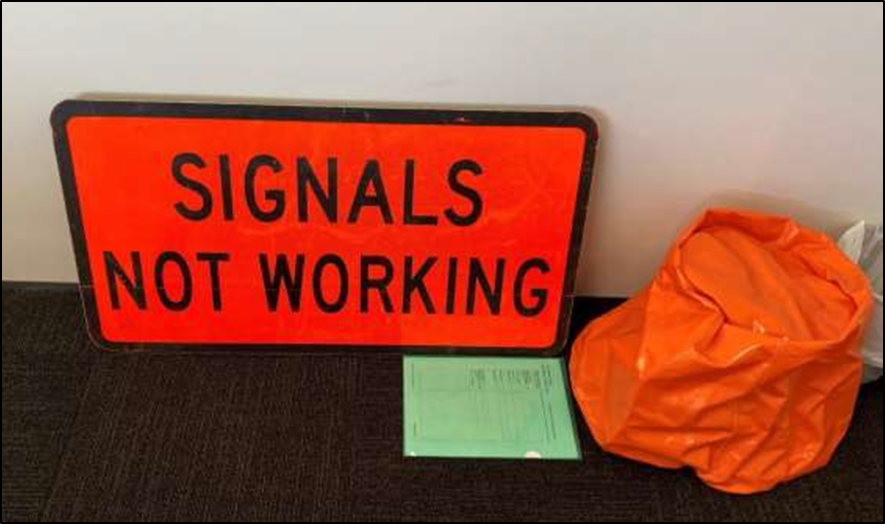
- There were no signals staff available to work on Sunday 7 August, so the Selwyn Street level crossing remained disconnected and was not protected by bells, lights or barriers. Rail traffic remained under a 10 km/h TSR and road traffic was notified by the ‘signals not working’ signage, which meant that road users were required to visually check to ensure the track was clear before entering the level crossing.
- Zero Harm (KiwiRail’s health, safety, and environment department) issued a further Special Bulletin on Monday 8 August that instructed train drivers about which signals required permission to pass from train control.
- On the morning of Monday 8 August, the signals technician who had attended on Saturday returned to Selwyn Street level crossing with another signals technician and a communications staff member. Using a cable fault locator, they found that the cable had been cut at a location where the cable ran underneath vegetation, initially hidden from view. The signals technicians then had to test both ends of both pieces of cable to ensure that there was no other damage. They then planned how to repair the damaged section of cable.
- At 1435 on Monday 8 August, with the Selwyn Street level crossing still disconnected, the driver of W6 Shunt, consisting of DXB class locomotive 5137 and DXR class locomotive 8022, contacted train control to inform them that a bus had just driven across the front of the train at the Selwyn Street crossing. The train driver reported that the bus did not appear to slow down at all.
- Figure 4 shows still images of the near miss from CCTV footage captured by a security camera located at a neighbouring business.
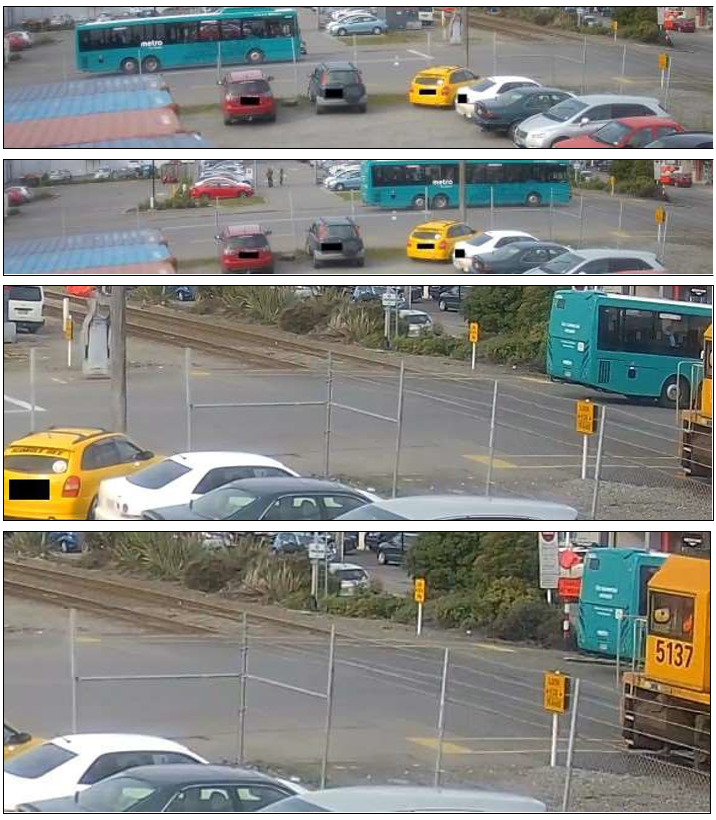
- A short time before this incident occurred, NZ Police had been informed by members of the public that the barriers were not working at nearby Lincoln Road crossing. NZ Police contacted train control by telephone to discuss the Lincoln Road concerns minutes after the train controller had been advised by the W6 Shunt driver of the bus near miss at Selwyn Street. Train control advised NZ Police of the Selwyn Street incident but did not have a vehicle registration or bus number for NZ Police to follow up with.
- Following the report of the near miss at Selwyn Street, signals staff organised for temporary traffic management to be put in place on the afternoon of 8 August. Traffic management remained in place until the fault was fixed on 9 August.
Train/Vehicle information
- W6 was the operating number assigned to the scheduled shunt service operated by KiwiRail. At that stage of the service W6 consisted of two locomotives: one DXB and one DXR class. The intention was for W6 to travel from Rolleston to Lyttelton.
- The bus was a 2011 MAN model 18.280 45-seater operated by Go Bus. The intention was for the bus to travel from Southshore to Hillmorton (Route 60). The number of passengers onboard at the time of the near miss was unknown.
Organisational information
- KiwiRail Holdings Limited, trading as KiwiRail, was the operator of the train and railway. When a fault occurs with a level crossing, KiwiRail has responsibility to respond and address the fault.
- Go Bus was a private bus operator and was New Zealand’s largest operator of passenger service vehicles. Go Bus provided passenger transportation services under contract to Environment Canterbury Regional Council.
Meteorological information
- The weather on the day of the incident, was overcast with some occasional light showers, but there was good visibility.
Recorded data
- Commission investigators obtained recordings of KiwiRail train control system activity, and telephone and radio communications relevant to the incident.
Other data sources
- CCTV footage of the incident was obtained from Waka Kotahi NZ Transport Agency (Waka Kotahi) and a local business. The bus involved in the incident had a CCTV camera installed. On the day of the incident, the CCTV camera was not working. Go Bus provided footage from another bus on the same route so that the investigation team could determine the positions and visibility of signage at the Selwyn Street level crossing (see Figures 5 and 6).
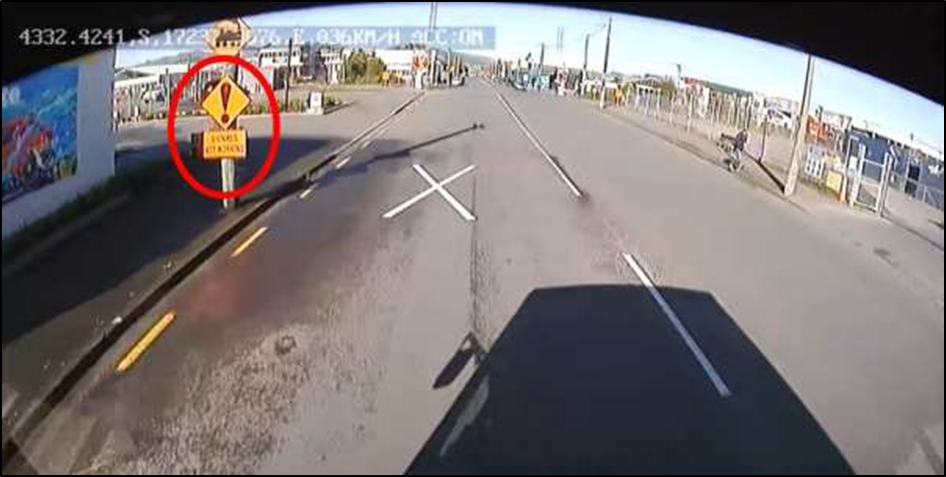
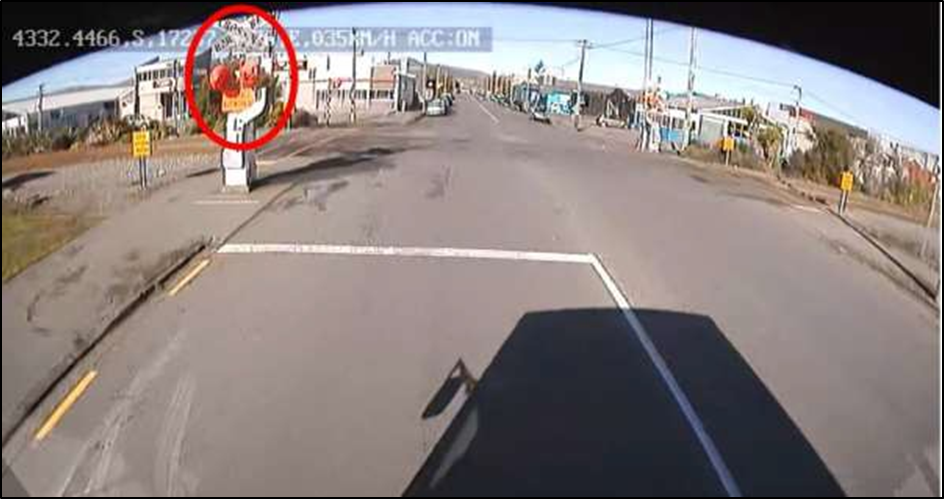
Previous occurrences
- On 7 December 2019, two people were fatally injured when the car they were travelling in collided with a freight train at the Piako Road level crossing, near Morrinsville (rail inquiry RO-2019-108 Level crossing collision Piako Road Morrinsville 7 December 2019, Transport Accident Investigation Commission November 2021). The Commission found that, at the time of the accident, the level crossing alarms were obscured during complex roadworks operations.
- The Commission recommended that Waka Kotahi review its current auditing of agencies delegated to approve traffic management plans, to ensure that applicants developing traffic management plans identify any rail crossings near the proposed work and that the rail access providers are consulted to ensure that any additional safety requirements in relation to the road–rail interface are met (https://www.taic.org.nz/recommendation/00621). In response Waka Kotahi advised the Commission that the proposed ‘New Zealand Guide to Temporary Traffic Management’ would address this recommendation. This guide was published by Waka Kotahi in April 2023.
- The Commission recommended that the Secretary for Local Government provide leadership to, and work with, local authorities to ensure that traffic management plans identify any rail crossings near proposed work and that rail access providers have been consulted to ensure that any additional safety requirements in relation to the road–rail interface are met (https://www.taic.org.nz/recommendation/00721). In response to the recommendation, the Secretary for Local Government informed the Commission that they do not consider that they have the ability to implement this recommendation.
- On 16 September 2020, a bus carrying 31 passengers collided with a locomotive at Clevely Line level crossing, near Feilding (rail inquiry RO-2020-103 Collision between bus and locomotive Clevely Line level crossing Bunnythorpe, 16 September 2020, Transport Accident Investigation Commission, December 2021). The bus driver was fatally injured. The Commission found that the bus driver did not stop before entering the level crossing despite the operation of bells and flashing lights.
- The Commission recommended that Waka Kotahi, in consultation with the rail industry, review clause 9.5(c) of the Land Transport (Road User) Rule 2004 to assess its adequacy regarding the risks posed by level crossings close to road intersections (https://www.taic.org.nz/recommendation/00821). On 12 December 2022 Waka Kotahi informed the Commission that the recommendation had been “added to the list of items for review by the policy team within Regulatory Services and engagement with Ministry of Transport is due to commence”.
Analysis Tātaritanga
Introduction
- This section analyses the circumstances surrounding the event to identify those factors that increased the likelihood of the event occurring or increased the severity of its outcome. It also examines any safety issues that have the potential to adversely affect future operations.
- In 2016, the Commission added “safety for pedestrians and vehicles using level crossings” (https://www.taic.org.nz/watchlist/level-crossing-safety-pedestrians-and-vehicles) to its Watchlist (The Commission publishes this list to draw public and industry attention towards transport safety risks and accident trends. see https://www.taic.org.nz/watchlist). When pedestrians or vehicles use level crossings, the potential exists for serious accidents to occur. Safety measures depend on infrastructure, technology, systems and users working together. A change in one of these factors must take into account its effect on the others if safety is not to be compromised.
- When a passenger bus traversed the Selwyn Street level crossing in front of an approaching locomotive, a potentially tragic accident was avoided by a matter of metres and by seconds. The bus driver did not realise that there was any danger, nor did they realise that a near miss had occurred. This analysis describes the measures taken to make level crossings safer, and the factors that led to unsafe conditions at the level crossing when the near miss occurred.
Risk control at road–rail interfaces
Safety issue: KiwiRail procedures did not adequately address the risk posed by unscheduled disconnections of level crossing protections.
- Level crossings are areas in which road traffic, pedestrians and other forms of traffic cross directly over the rail corridor. The risk to road users and rail traffic at a level crossing can be reduced by controlling access to the rail corridor through active and passive controls.
- Active controls are traffic-control devices, such as bells, lights and barrier arms, that are activated when a train approaches the level crossing.
- Passive controls, such as warning signs, road markings and rumble strips, are present at all times, regardless of whether a train is approaching.
- Both active and passive controls are intended to warn road users that they are approaching a level crossing and to act accordingly. Passive controls rely on road users making safe decisions and taking appropriate actions. Active controls go further to instruct a road user to stop and, in the case of barrier arms, provide an obstacle across the road approaching the level crossing.
-
There are over 3000 level crossings in New Zealand. Each is ranked according to the level of risk posed to road users and provided with the protection systems necessary to reduce the risk to ‘as low as is reasonably practicable’ (ALARP). KiwiRail traditionally used the Australian Level Crossing Assessment Model (ALCAM) safety-assessment tool to help prioritise treatment of level crossings according to their comparative safety risk. In 2017 KiwiRail, in conjunction with Waka Kotahi and the Road Controlling Forum, introduced a new risk-assessment process called the Level Crossing Safety Impact Assessment (LCSIA) to help to objectively assess level crossings. Waka Kotahi’s Level Crossing Risk Assessment Guidance document stated in part:
A key component of the LCSIA was a risk scoring system called the Level Crossing Safety Score (LCSS). Together with the traditional ALCAM level-crossing risk model score, the LCSS also looks at three additional data sources associated with crash risks: historical crash & incident data, risk ratings by Locomotive Engineers and Road Controlling Authority (RCA) Engineers, and a detailed site-specific safety score (SSSS) assessment of the level crossing layout for vehicles / cyclists / pedestrians and their interaction with the crossing and the surrounding transport network. The LCSIA process also enables the prioritisation of level crossing upgrades (Waka Kotahi. (2022). Level Crossing Risk Assessment Guidance, Version 5).
- The Selwyn Street level crossing (with its installed protections operating correctly) was ranked as the 1950th most hazardous level crossing in New Zealand. It was protected by warning bells and lights, half-boom barrier arms, roadside signage and warning signage painted on the road. When the cables were cut the level crossing alarms and barrier defaulted to ‘fail-safe’ mode, meaning the barrier arms remained lowered and the bells and lights were operating continuously. Effectively the level crossing was closed to road traffic, and the risk of a road–rail collision was minimised.
- When the decision was made to bypass the fail-safe mode and disconnect the level crossing alarms and barriers before the problem was rectified, it effectively reopened the level crossing to road traffic, but with a far lower standard of protection – passive protection only in the form of ‘signals not working’ signage and high visibility covers over the warning lights.
- KiwiRail’s Task Instructions on disconnecting level crossing alarms and barriers (KiwiRail Signals and Telecommunications Task Instruction Level Crossing Alarms and Barrier Installations S-TI-MA-2614 SR.14.4 (see Appendix A))(see Appendix 1) gave instruction for when the disconnection was unplanned to implement a 10 km/h speed restriction for trains, fix signals at stop, cover warning lights and establish signage. For a planned disconnection, further risk mitigation in the form of a traffic management plan was required.
- As the circumstances of the disconnection leading up to this near miss were not planned, it meant that the level crossing was opened to road traffic with an inadequate level of protection, and without any instruction to staff to assess the risk of the crossing being opened in that condition.
- KiwiRail’s Task Instructions for disconnecting level crossing alarms and barriers after failure or malfunction did not require a risk assessment.
- If a risk assessment had been carried out, it would very likely have identified that leaving the level crossing open with only the minimum of passive protection would not provide an acceptable level of risk control for this crossing.
Safety issue: KiwiRail did not conduct a risk assessment when the level crossing protections were disconnected. A 10 km/h temporary speed restriction for trains and ‘signals not working’ signage was not adequate mitigation to a dress the increased risk in the circumstances.
- Although there was an increase in protective measures for rail traffic following the disconnection of the level crossing alarms and barrier, by instituting a 10 km/h speed restriction, the overall reduction in protections for road users increased the risk of collision between a train and a road vehicle. Despite the train approaching at a lower speed, any collision could still have resulted in serious harm and/or damage.
- The Railways Act 2005 states that rail vehicles have right of way and a rail operator is entitled to assume that road users will keep clear of the railway line (Railways Act 2005, s80(1)). In particular, the general requirement is for road users to approach a level crossing with vigilance and to give way to rail traffic. However, if road users are accustomed to active protection at a particular level crossing, their ability to recognise that it is now unprotected is reliant on how effectively this is communicated to them.
- During their interview, the bus driver stated that they did not recall seeing any warning signage and they were not aware that the level crossing alarms were out of action. However, CCTV footage shows that the signs were in place when the near miss occurred.
- In the case of Selwyn Street, the signage KiwiRail used to inform traffic that the crossing was now unprotected was not effective. Road users approaching level crossings can be overloaded with stimuli within complex urban traffic systems, which detracts from the attentional resources available to support their situational awareness when crossing (Wigglesworth, E. (2001). A human factors commentary on innovations at railroad-highway grade crossings in Australia. Journal of Safety Research, 32, 309-321). Given the prominence of orange roadwork signage and traffic cones in the inner city since the 2011 earthquake, the use of orange covers and an orange traffic sign is unlikely to provide enough object salience for road users to distinguish their presence.
- On the day of the incident, the usual cues that would have indicated to the bus driver that it was not safe to enter the level crossing were absent. The warning signage placed by KiwiRail to inform road users that those usual cues were not operating did not attract the bus driver’s attention. It is likely they continued to drive across the level crossing without taking additional precautions, such as visually confirming the absence of trains, because without flashing red lights, bells and lowered barriers, they considered that it was safe to proceed.
- The bus driver did not realise that there was a locomotive approaching the level crossing, so they continued across the level crossing and along the scheduled route as normal. They did not know that a near miss incident had occurred.
- When all lights, bells and barriers were working, the Selwyn Street level crossing had maximum protection to mitigate against a collision between road and rail vehicles. When the signals malfunctioned and the level crossing defaulted to fail-safe mode, maximum protection was maintained
- However, when the level crossing alarms and barrier were disconnected, the signs and covers required by KiwiRail’s Task Instructions were inadequate to alter the habits of road users accustomed to the normal day-to-day conditions at the Selwyn Street level crossing. It was almost certain that this downgrading of protections from high-level active controls to low-level passive controls increased the risk to both road users and rail traffic.
- Level crossings are areas where the potentially hazardous rail corridor is accessible to any person regardless of their knowledge, skills or experience. It follows that the safety controls, installed to keep risk as low as is reasonably practicable, should be designed to remove or effectively reduce foreseeable errors.
- The ALCAM assessments assign risk in one of five bands: high, medium-high, medium, medium-low and low. As part of this investigation, the risk band of the Selwyn Street level crossing was tested by being entered into the ALCAM system with no protection other than the 10 km/h rail speed restriction.
- With the new parameters entered, the risk assigned to the crossing increased from medium-low to medium.
- The change in risk band was based on the assessment that the reduction in train speed to 10 km/h would enable a train driver to stop in a shorter distance.
- The Commission accepts that in this situation, rail traffic would have to stop for the signal just before the crossing. However, even if rail traffic were travelling at a speed below the 10 km/h restriction, the assessment did not take into account the speed that road traffic might be travelling at in a hypothetical collision with a train, nor that road traffic might potentially drive at speed into the side of a train on the unprotected crossing before the train driver could react.
- Figures 7–9 show traffic counts in the vicinity of the Selwyn Street level crossing up to March 2022. At the time of the incident this was the latest count available on CCC’s traffic count data website. Figure 7 shows the traffic count, while Figures 8 and 9 show the recorded north and southbound speeds of that traffic.
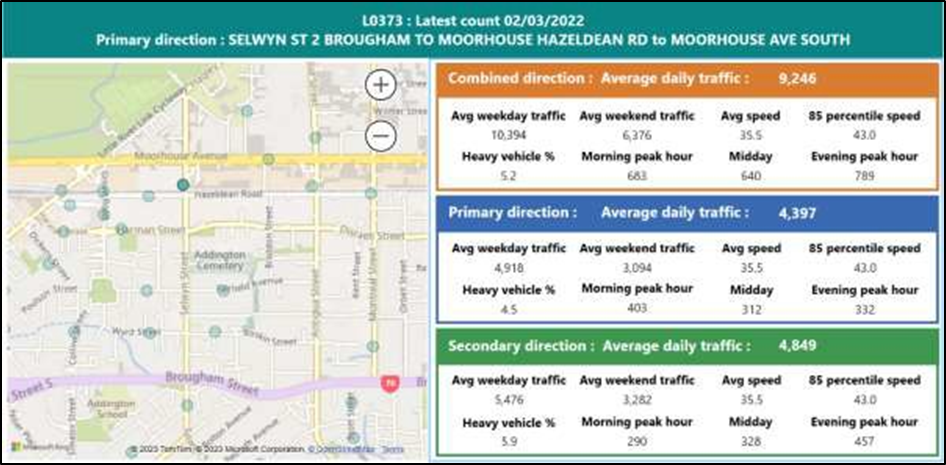


- As Figures 7–9 show, there were an average of over 10,000 road traffic movements recorded in the vicinity of the crossing on weekdays, and over 6,000 during the weekend. The speeds of these road traffic movements are largely within the 50 km/h posted speed limit. However, there is a small but consistent amount of traffic exceeding the posted speed limit, some by a considerable margin.
- Had KiwiRail’s Task Instruction required a site-specific risk assessment for any unplanned disconnection of the level crossing alarms and barriers, it should have led to other safety measures (such as temporary traffic management) being considered in addition to implementing a 10km/h speed restriction for rail traffic, placing ‘signals
- A recommendation has been made to KiwiRail to address these safety issues (see paragraph 6.3) not working’ road signage and covering the alarms.
Safety issue: The road controlling authority was not informed of the fault at the level crossing and not consulted on potential risk controls.
- A rail access provider, such as KiwiRail, may install warning devices and signs at a level crossing as it considers necessary for the protection of people using the level crossing. In considering what is necessary to provide that protection, the rail access provider must consult any other parties directly involved with the operation or management of the level crossing (Railways Act 2005, s 81(1) and s81(2)), including the road controlling authority (in this instance CCC), with the objective of agreeing on the warning devices and signs to be erected.
- KiwiRail’s Task Instruction for level crossing alarms and barriers detailed inspection periods and methods of carrying out maintenance. The Task Instruction contained a Specific Rule, SR.14.4, for disconnection of level crossing alarms and barriers because of failure or other events. The Task Instruction did not specify any requirement to notify the road controlling authority of the fault or consult with them to agree on the appropriate safety measures for the level crossing.
- When the decision was made by KiwiRail to disconnect the level crossing alarms and barriers, no consultation had occurred with CCC. As the road controlling authority, CCC informed the Commission that it expected coordination, communication and collaboration on matters of safety when its duties under the Health and Safety at Work Act overlapped those of KiwiRail (Health and Safety at Work Act 2015, s34(1)). In particular, CCC expected to be notified by KiwiRail of any variation to the normal operating condition of the road.
- Had consultation occurred, as required by the Railways Act 2005 and Land Transport Rules (Land Transport Rule: Traffic Control Devices 2004 (Rule 54002) Rule 9.2), KiwiRail and CCC could have agreed on appropriate safety controls at the level crossing.
- CCC were not notified by KiwiRail that the Selwyn Street level crossing alarms and barriers had malfunctioned until three days after the fault occurred, when KiwiRail’s temporary traffic management provider logged a Notification of Works, using a pre-approved generic traffic management plan, for planned work at the level crossing from 9 to 12 August 2022.
- Had CCC been aware of the fault, it is very likely that, as the road controlling authority, CCC would not have agreed to the minimal passive controls at the Selwyn Street level crossing.
- The Commission has made a recommendation to KiwiRail to address this safety issue (see paragraph 6.4).
Large passenger service vehicles and exceptions from compulsory stop at level crossings
- Following inquiry RO-2020-103 into the September 2020 accident, in which a passenger bus collided with a locomotive near Feilding (see paragraph 2.35), the Commission recommended that Waka Kotahi, in consultation with the rail industry, review clause 9.5(c) of the Land Transport (Road User) Rule 2004 to assess its adequacy regarding the risks posed by level crossings in close proximity to road intersections.
- The Land Transport (Road User) Rule 2004 contains a general requirement for large passenger service vehicles to stop clear of the railway line and take adequate observations to ensure the line is clear before entering a level crossing (Land Transport (Road User) Rule 2004, 9.4(1), (2)). However, this requirement to stop and observe does not apply when the level crossing has barrier arms or signal lights installed (Land Transport (Road User) Rule 2004, 9.5(b), (c)).
- The Selwyn Street level crossing had both warning lights and barrier arms installed. Under normal operating conditions, it could be considered safe for a vehicle to enter the level crossing when the bells and lights were off and the barrier arms were raised. However, the Rule defines ‘install’ as ‘place in position’ (Land Transport (Road User) Rule 2004, 1.6 Interpretation) and does not account for times when the installed protection equipment is inoperative.
- The Rule is silent on what action the driver of a large passenger service vehicle should take when the installed barrier arms or warning lights are malfunctioning.
Findings Ngā kitenga
- The fault was difficult for the attending staff to identify and locate. Their focus was on system rectification. The consequences of the fault for the safety of road users and rail traffic were not recognised.
- There were several staff members unavailable for call out work during this particular weekend and there was nobody available to work at the site the following day. Had more staff been available the fault would likely have been repaired sooner.
- Due to the fault occurring on a weekend there was no escalation to a senior operational level. Network Control (based in Wellington) implemented no further risk mitigation beyond a speed restriction for rail vehicles.
- Had the risks of the fault been fully recognised it should have led to adequate controls, such as temporary traffic management, being arranged.
- Placement of the signage was in accordance with KiwiRail’s Signals and Telecommunications Task Instruction – Level Crossing Alarms and Barrier Installations (Specific Rule SR.14.4). However, the Task Instruction only required the placement of a 10 km/h speed restriction and warning signage when level crossing alarms and barriers were disconnected.
- The Task Instruction had a further requirement for a traffic management plan to be in place “for planned suspension of Crossing Alarms”. The disconnection of Selwyn Street was not planned; therefore, a traffic management plan was not required.
- NZ Police and CCC were not notified by KiwiRail of the fault at the level crossing.
- As a result of the limited passive controls put in place, the level crossing was left in a state that offered little protection to road users or rail traffic.
- Had the Task Instruction required a risk assessment of the consequences of disconnecting level crossing alarms or barriers and had appropriate risk controls been put in place, the incident would almost certainly have been avoided.
- The implementation of a 10 km/h speed restriction for rail traffic alone did not adequately address the risk, although it would likely have reduced the consequences of a collision.
- The Land Transport (Road User) Rule 2004 is silent on what is expected from a driver of a large passenger service vehicle, which is exempt from stopping at level crossings with specified protections installed, when those protections are inoperative.
Safety issues and remedial action Ngā take haumanu me ngā mahi whakatika
General
- Safety issues are an output from the Commission’s analysis. They may not always relate to factors directly contributing to the accident or incident. They typically describe a system problem that has the potential to adversely affect future transport safety.
- Safety issues may be addressed by safety actions taken by a participant, otherwise the Commission may issue a recommendation to address the issue.
Risk assessment and risk control
Safety issue: KiwiRail procedures did not adequately address the risk posed by unscheduled disconnections of level crossing protections.
Safety issue: KiwiRail did not conduct a risk assessment when the level crossing protections were disconnected. A 10 km/h temporary speed restriction for trains and ‘signals not working’ signage was not adequate mitigation to address the increased risk in the circumstances.
- When signals staff found that they could not make a timely repair the decision was made to disconnect the level crossing alarms and barrier. This effectively reopened the level crossing, but with a far lower standard of protection.
- KiwiRail’s Task Instruction on disconnecting level crossing alarms and barriers did not require a site-specific risk assessment and did not require any additional safety controls unless the disconnection was due to planned maintenance on the level crossing. For a planned disconnection, a traffic management plan was required.
- There was limited staff available to work during the weekend and procedures allowed that signals staff could leave the level crossing with less protection than normal without reassessing the risk of the level crossing.
- Mitigation in the form of a 10 km/h temporary speed restriction for trains and ‘signals not working’ road signage was not adequate in the circumstances. Although the speed restriction reduced the momentum of the locomotive, there was still a higher potential for a collision with a road user entering the level crossing without taking adequate observations.
- No safety actions have been taken at this stage and the Commission has issued a recommendation to KiwiRail to address these safety issues (see paragraph 6.3).
Safety issue: The road controlling authority was not informed of the fault at the level crossing and not consulted on potential risk controls.
- The Railways Act 2005 (34 Section 81(2)) required that the rail access provider and the road controlling authority collaborate on safety controls for level crossings. KiwiRail was required to notify CCC of any variation in the normal road operating conditions that arose from rail activities.
- KiwiRail’s Task Instruction for disconnecting level crossing alarms and barriers did not require the road controlling authority to be notified.
-
On 1 August 2023 CCC responded in part:
We would welcome a recommendation that details the following are noted in any process updates:
Timeframes for when the Council is advised of any signal outages.
- Timeframes and/or conditions when comprehensive temporary traffic management will be installed on the road network.
- Who is responsible for advising any specific or high user groups (e.g., bus companies).
- Names the lead agency for any actions and details the timeframes for completing any actions.
- What are the mechanisms for communicating process changes to other Road Controlling Authorities across the country.
- No safety actions have been taken at this stage and the Commission has issued a recommendation to KiwiRail to address this safety issue (see paragraph 6.4).
- The Commission’s recommendation addresses the identified safety issue in the system. However, the specific details of how the recommendation is addressed are a matter for KiwiRail to develop with road controlling authorities.
Recommendations Ngā tūtohutanga
General
- The Commission issues recommendations to address safety issues found in its investigations. Recommendations may be addressed to organisations or people and can relate to safety issues found within an organisation or within the wider transport system that have the potential to contribute to future transport accidents and incidents.
- In the interests of transport safety, it is important that recommendations are implemented without delay to help prevent similar accidents or incidents occurring in the future.
New recommendations
- On 27 September 2023, the Commission recommended that KiwiRail adequately address the risk posed by disconnecting level crossing protections, whether planned or unplanned. (031/23)
- On 27 September 2023, the Commission recommended that KiwiRail work with road controlling authorities to develop processes for notification, risk assessment and traffic management measures for unplanned level crossing disconnections. (032/23)
-
On 16 October 2023, KiwiRail replied:
031/23: The Commission recommended that KiwiRail adequately address the risk posed by disconnecting level crossing protections, whether planned or unplanned
This recommendation is under consideration.
032/23: The Commission recommended that KiwiRail work with road controlling authorities to develop processes for notification, risk assessment and traffic management measures for unplanned level crossing disconnections
This recommendation is under consideration.
Notice of recommendation
- The Commission gives notice to all road controlling authorities within New Zealand that it has issued recommendation (032/23) to KiwiRail and that these recommendations will require the involvement of those road controlling authorities.
Key lessons Ngā akoranga matua
- Risk assessments and associated mitigations are based on the controls in place at the time of the assessment. Removal of any of these risk controls without reassessment may increase risk to an unacceptable level.
Data summary Whakarāpopoto raraunga
Details
Conduct of the Inquiry He tikanga rapunga
- On 9 August 2022 Waka Kotahi notified the Commission of the incident. The Commission subsequently opened an inquiry under section 13(1) of the Transport Accident Investigation Commission Act 1990 and appointed an Investigator-in-Charge.
- The Commission obtained documents and records for analysis, including:
- interviews conducted with signals staff and the bus driver
- written statement made by the train driver
- Global Positioning Satellite (GPS) information from the bus
- CCTV footage of the incident from Waka Kotahi, Go Bus and neighbouring businesses
- train control system playback recordings and graphs
- Special Bulletins issued by KiwiRail relevant to the incident
- KiwiRail Task Instructions relevant to the incident
- enquiries with Christchurch City Council
- On 25 May 2023 the Commission approved a draft report for circulation to eight interested parties for their comment.
- The Commission received submissions from six interested parties. Any changes resulting from those submissions have been included in this final report.
- On 27 September 2023 the Commission approved the final report for publication.
Glossary Kuputaka
- Bypass the alarms
- A method of connecting electrical circuits directly to the power source by diverting around (bypassing) potentially faulty equipment. This allows the rest of the circuit to continue operating normally. It is used by signals technicians in emergency situations or for fault-finding.
- 'Fail-safe' mode
- If a malfunction occurs, the train control system is designed to activate the flashing lights, bells and barriers by default. This ensures the level crossing – even if it has failed – is ‘safe’.
- Large passenger service vehicle
- Any passenger service vehicle that is designed or adapted to carry more than 12 people (including the driver)
- Rail access provider
- Person who controls the use of a railway line by rail operators (including that person if it is also a rail operator)
- Road controlling authority
- The authority, body or other person that has control of a road; and includes a person acting under, and within the terms of, any delegation or authorisation given by that authority, body or other person
- Special Bulletin
- An internal memorandum issued to KiwiRail staff containing information and instructions temporarily altering a normal method of operation.
- Speed boards
- Trackside equipment displaying the maximum speed for that section of track.
- Zero Harm
- KiwiRail’s health, safety and environment department
Appendix 1. KiwiRail Signals and Telecommunications Task Instruction SR.14.4: Level crossing alarms and barrier installations
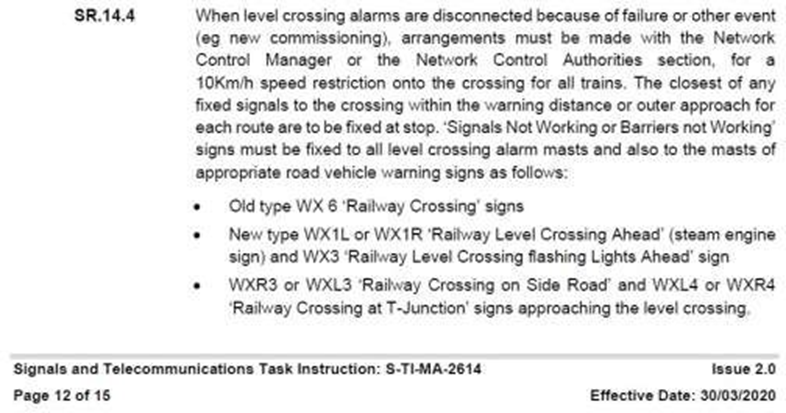
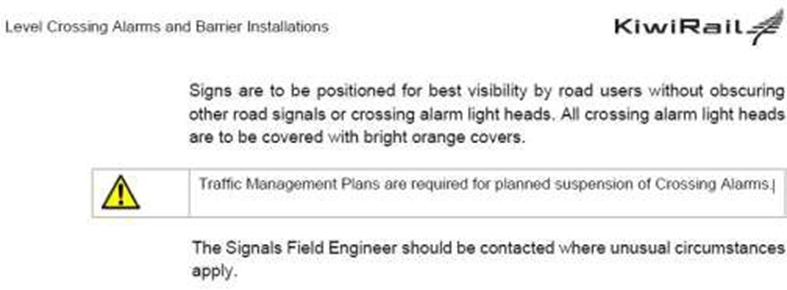
Related Recommendations
On 27 September 2023, the Commission recommended that KiwiRail adequately address the risk posed by disconnecting level-crossing protections, whether planned or unplanned.
On 27 September 2023, the Commission recommended that KiwiRail work with road controlling authorities to develop processes for notification, risk assessment and traffic management measures for unplanned level-crossing disconnections.
